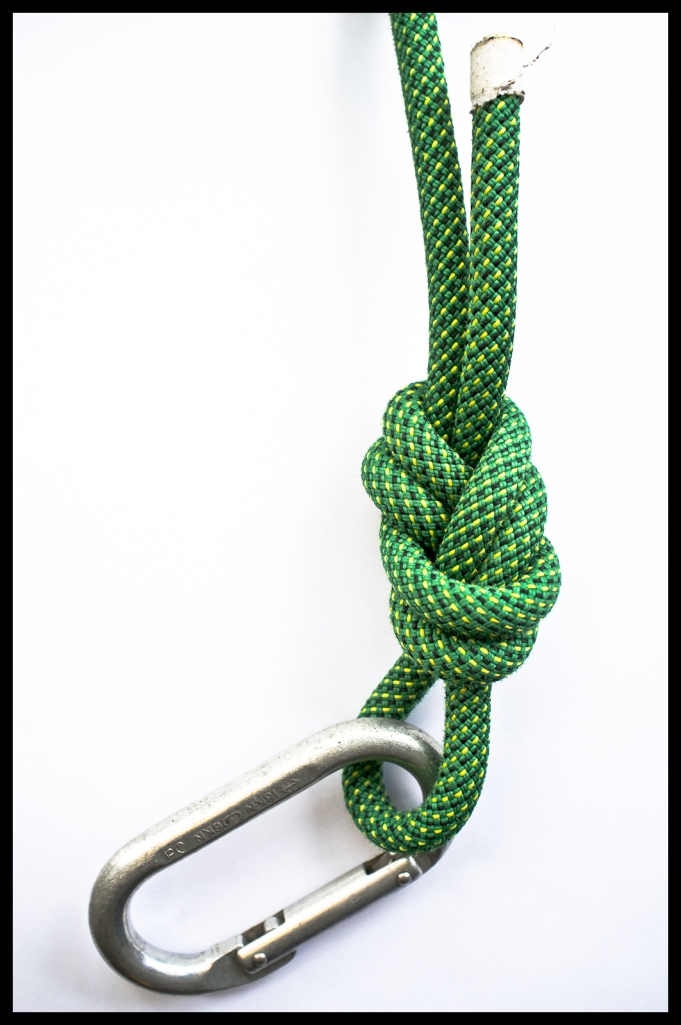A stopper knot is any knot tied at the end of a rappel rope that prevents a climber from rappelling off the end of the rope. Many accidents and fatalities are a result of insufficient stopper knots or none at all.
RULES OF THE STOPPER KNOT:
-
A stopper knot must be larger than the passage/clearance of the rappel device being used
-
A stopper knot is dependent on the diameter of line being used (thinner diameter lines require larger stopper knots)
-
Stopper knots must be placed on BOTH lines if rappelling off running lines
-
Always check the ends of your rope(s) for adequate stopper knots
In July of 2009 I had a stopper knot slip thru my hand while wrestling with a banner on Mount Rushmore near Keystone, South Dakota. Things were hectic and I was exhausted and dehydrated. It happened fast and before I knew it I was 300ft in the air and hanging out between good ol’ Teddy and Abe with a double overhand stopper knot jammed into my rappel device (I was using the Petzl STOP).
Moral of the story? Tie a knot at the end of your rope! But remember – NOT ALL STOPPER KNOTS ARE CREATED EQUAL!
Stopper knots come in all shapes and sizes. Choosing which is best can prevent a lot of hassle and even save your life. Use this list of six with the rules above to help you choose the best stopper knot for any given situation.
DOUBLE OVERHAND
Pros
- Simple
- Fast
- Uses minimal rope
Cons
- Slim profile (rope diameter and rappel device must be carefully considered!)
TRIPLE OVERHAND
Pros
- Simple variation to double overhand
- Larger profile than double overhand
Cons
- More likely to get jammed or stuck on edges or in cracks/crevices
QUADRUPLE OVERHAND
Pros
- Variation to triple overhand
- Larger profile than triple overhand
Cons
- Requires more rope than the other overhand variations
- More likely to get jammed or stuck on edges or in cracks/crevices
- More cumbersome to tie than the other overhand variations
CAPUCHIN (double overhand on a bight)
Pros
- Simple
- Wide profile (ball shape)
- Good choice for thinner diameter ropes or rappel devices with greater clearance
- Knot of choice for figure 8 descender or when descending with a mule hitch (carabiner dependent!)
Cons
- Requires a fair amount of rope
- More likely to get jammed or stuck on edges or in cracks/crevices
- Open loop is a point for snagging
FIGURE EIGHT ON A BIGHT
Pros
- Simple
- Fast
- Large profile
- Good choice for thinner diameter ropes or rappel devices with greater clearance
Cons
- Requires a fair amount of rope
- More likely to get jammed or stuck on edges or in cracks/crevices
- Open loop is a point for snagging
FIGURE EIGHT ON A BIGHT WITH ADDED CONNECTOR
Pros
- Fast and easy variation to the figure eight on a bight
- Large profile
Cons
- More likely to get jammed or stuck on edges or in cracks/crevices
- Open loop and connector is a point for snagging
- Requires more gear
- Hard gear has the potential to damage surroundings or injure bystanders







